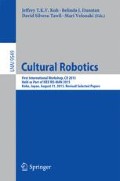Abstract
This chapter draws upon the author’s experimental video artwork Comfortable and Alive, made with the Japanese gynoid robot Geminoid-F by ATR Hiroshi Ishiguro Laboratories, to facilitate a wider, yet fractional, discussion of the cultural provenance and potential integration of specifically female-appearing android robots (gynoids). The “display architecture” of the gynoid can be viewed as an aesthetic emulation by robot designers of the centuries-old characterization of girls and women as naïve, pretty, submissive and soothing; this construction also pervades televised and other media. At the present time it is viewed as ideal that the service gynoid should make humans feel comfortable, most often in companionship, entertainment, hostessing, and reception roles. The artwork raises poignant issues pertaining to machine translation, and human–machine affinity, in context of the replication in robots of societal gender norms.
Access this chapter
Tax calculation will be finalised at checkout
Purchases are for personal use only
References
Fukada, K.: Sayônara (Feature film). Phantom Film, Tokyo (2015)
Haring, K.S.: Gender differences paper. Personal e-mail, 12 June 2014
Nishio, S., Ishiguro, H., Hagita, N.: Geminoid: teleoperated android of an existing person. In: de Pina Filho, A.C. (ed.) Humanoid Robots, New Developments, pp. 343–352. I-Tech, Vienna (2007)
Ogawa, K., Taura, K., Ishiguro, H.: Possibilities of androids as poetry-reciting agent. In: Proceedings of 21st IEEE International Symposium on Robot and Human Interactive Communication, pp. 565–570 (2012)
Springer, C.: The pleasure of the interface. In: Wolmark, J. (ed.) Cybersexualities, pp. 34–54. Edinburgh University Press, Edinburgh (1999)
Matsumoto, Y.: Interview: incredibly realistic male and female android robots from Japan. In: Actroid, F.(ed.) DigInfo. https://www.youtube.com/watch?v=DF39Ygp53mQ. Accessed 2 Dec 2014
Guizzo, E.: Meet Geminoid F, a smiling female android. IEEE Spectrum, March 2010. http://spectrum.ieee.org/automaton/robotics/humanoids/040310-geminoid-f-hiroshi-ishiguro-unveils-new-smiling-female-android. Accessed 16 Mar 2016
Miraikan (National Museum of Emerging Science and Innovation). Android: What is Human? (Exhibition) (2014). http://www.miraikan.jst.go.jp/en/exhibition/future/robot/android.html. Accessed 16 Mar 2016
McCurry, J.: Erica, the ‘most beautiful and intelligent’ android, leads Japan’s robot revolution. Guardian, December 2012. http://www.theguardian.com/technology/2015/dec/31/erica-the-most-beautiful-and-intelligent-android-ever-leads-japans-robot-revolution. Accessed 16 Mar 2016
Ahn, H.S., Lee, D-W., Choi, D., Lee, D-Y., Hur, M., Lee, H.: Uses of facial expressions of android head system according to gender and age. In: Proceedings of IEEE International Conference on Systems, Man, and Cybernetics, pp. 2300–2305 (2012)
T. Kim: Scientists test out all-robot dramas. Korea Times, February 2010. http://koreatimes.co.kr/www/news/tech/2010/02/129_60585.html. Accessed 16 Mar 2016
Wood, G.: Edison’s Eve: A Magical History of the Quest for Mechanical Life. Alfred A. Knopf, New York (2002)
de Fren, A.: The exquisite corpse: disarticulations of the artificial female. Doctoral thesis, University of Southern California, Los Angeles (2008)
Frost, A.: Anatomical venus: the gory idealized beauty of wax medical models. http://dangerousminds.net/comments/anatomical_venus_the_gory_idealized_beauty_of_wax_medical_models. Accessed 16 Mar 2016
Kim. T.: Robot creators face design paradox. Korea Times, April 2007. http://koreatimes.co.kr/www/news/tech/2007/04/129_886.html. Accessed 16 Mar 2016
Carroll, C.: Us – and them. Natl. Geogr. Mag., August 2011. http://ngm.nationalgeographic.com/2011/08/robots/carroll-text. Accessed 16 Mar 2016
Suchman, L.A.: Human-Machine Reconfigurations: Plans and Situated Actions. Cambridge University Press, New York (2007)
Australian Broadcasting Commission: Japan unveils android newsreader. News, June 2014. http://www.abc.net.au/news/2014–06-25/an-japan-unveils-android-newsreader/5547886. Accessed 16 Mar 2016
Government of Japan (2007): Innovation 25: Creating the Future. Cabinet Office, Tokyo (2007). http://www.cao.go.jp/innovation/innovation/point.html. Accessed 26 Sep 2014
Robertson, J.: Gendering humanoid robots: robo-sexism in Japan. Body Soc. 16(2), 1–36 (2010)
Butler, J.: Gender Trouble: Feminism and the Subversion of Identity. Routledge, New York (1990)
de Lauretis, T.: Technologies of Gender: Essays on Theory, Film, and Fiction. Indiana University Press, Bloomington (1987)
Halberstam, J.J.: Female Masculinity. Duke University Press, Durham (1998)
Aira, C.: Lovotics and the possibility of falling in love with robots someday. Silicone Angle, September 2013. http://siliconangle.com/blog/2013/09/20/lovotics-and-the-possibility-of-falling-in-love-with-robots-someday. Accessed 16 Mar 2016
Ueno, T.: Japanimation and techno-orientalism. In: Grenville, B. (ed.) The Uncanny: Experiments in Cyborg Culture, pp. 223–231. Vancouver Art Gallery & Arsenal Pulp Press, Vancouver (2001)
Levy, D.: Love and Sex with Robots. Harper Collins, New York (2007)
Oda, M.: Welcoming the libido of the technoids who haunt the junkyard of the Techno-Orient, or The uncanny experience of the post-techno-orientalist moment. In: Grenville, B. (ed.) The Uncanny: Experiments in Cyborg Culture, pp. 249–264. Vancouver Art Gallery & Arsenal Pulp Press, Vancouver (2001)
Dick, P.K.: Do Androids Dream of Electric Sheep?. Doubleday, New York (1968)
Haraway, D.: A manifesto for cyborgs: Science, technology, and socialist feminism in the 1980s. Socialist Rev. 80, 65–107 (1985)
Cutler, R.L.: Warning: sheborgs/cyberfems rupture image-stream! In: Grenville, B. (ed.) The Uncanny: Experiments in Cyborg Culture, pp. 187–200. Vancouver Art Gallery & Arsenal Pulp Press, Vancouver (2001)
Haraway, D.: Simians, Cyborgs, and Women: The Reinvention of Nature. Free Association Books, London (1991)
Hasegawa, T., Collins, M.: The importance of random learning – Hiroshi Ishiguro interviewed by Cloud Lab. Volume Mag. 28, 124–127 (2011)
Baudrillard, J.: The Anti-Aesthetic. Bay Press, Seattle (1991)
Ely, B.: Change and continuity: the influences of Taoist philosophy and cultural practices on contemporary art practice. Doctoral thesis, University of Western Sydney, Sydney (2009)
Castañeda, C., Suchman, L.A.: Robot visions. Soc. Stud. Sci. 44(3), 315–341 (2014)
Ridgeway, C.L.: Framed by Gender: How Gender Inequality Persists in the Modern World. Oxford University Press, New York (2011)
Irigaray, L.: Speculum of the Other Woman. Cornell University Press, Ithaca (1974, 1985)
Donovan, S.K.: Luce Irigaray (1932–). Internet Encyclopedia of Philosophy (2005). http://www.iep.utm.edu/irigaray Accessed 16 Mar 2016
Acknowledgments
This work was supported by the Australian Federal Government through an Australian Postgraduate Award.
Comfortable and Alive has been shown in 2015 at UNSW Galleries, Sydney in the solo exhibition Beyond Beyond the Valley of the Dolls, and in 2016 at Gus Fisher Gallery, Auckland in the group exhibition Alter. For preview screeners, contact the artist at elenaknox.com.
Author information
Authors and Affiliations
Corresponding author
Editor information
Editors and Affiliations
Rights and permissions
Copyright information
© 2016 Springer International Publishing Switzerland
About this paper
Cite this paper
Knox, E. (2016). ‘Face Robots’ Onscreen: Comfortable and Alive . In: Koh, J., Dunstan, B., Silvera-Tawil, D., Velonaki, M. (eds) Cultural Robotics. CR 2015. Lecture Notes in Computer Science(), vol 9549. Springer, Cham. https://doi.org/10.1007/978-3-319-42945-8_11
Download citation
DOI: https://doi.org/10.1007/978-3-319-42945-8_11
Published:
Publisher Name: Springer, Cham
Print ISBN: 978-3-319-42944-1
Online ISBN: 978-3-319-42945-8
eBook Packages: Computer ScienceComputer Science (R0)

